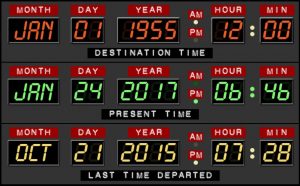Here are 10 things to review to make sure your site visitors don’t think they’re back in time.
Unless you’re with a consumer product company targeting millennials and teens, keeping your organization’s website on the “cutting edge” shouldn’t necessarily be an actual goal for your team. But keeping it modern and effective from a business perspective with an engaging user experience and great - often inexpensive - marketing technology is extremely important.

Your website is often the very first way that potential customers will interact with you. So providing an experience that truly represents your brand and has the best chance of making the prospect a customer should be the goal.
To get a sense of whether or not your site is stuck in 1955 at the Enchantment Under the Sea dance, use this 10 point checklist as a 1.21 gigawatt starting point.
1. Have you updated your website's content over the past year?
Keeping your website fresh with updated or new content is sort of like hitting the gym. While it’s not always easy to do, it’s definitely good for you and becomes easier once you get into a regular routine.
Why is fresh content important? Well, primarily it tells your site visitors that you’re a dynamic, vibrant business with new things to say—which encourages return visits. Additionally, it can help with your search engine results: Google actually factors in a Content Freshness score in its algorithm.
What kind of content should you be adding? Having a blog can be one option but only if you have the capability and desire to continuously update it (the internet is littered with failed blog attempts). It’s easier to write about your customers and the products or projects you are delivering to them. Such content generally has a longer shelf life and can draw potential new customers. Plus, it demonstrates your subject matter expertise and shows how active your business is.
2. Can you easily manage content on your website?
If your answer to question #1 was “No,” it’s possible that you’re not able to easily update content on your website. Maybe your site was built on a hard-to-use content management system (CMS) or has no CMS at all.
CMS software makes it easy for people with no technical capabilities to manage a website. You can choose from a ton of CMS platform options, covering all budget ranges and functionality requirements. There are well established open source platforms like WordPress and Drupal, build-your-own website platforms like SquareSpace and Weebly, and more complex, licensed solutions like Sitecore, Kentico, or at the highest-end, Adobe.
The solution you choose must meet the needs you have today. Yes, they all update frequently. But your current business needs might be different in two to three years. By then, a completely different platform might make more sense due to changes in your business, technology improvements or new trends in how visitors interact on the web. So, don’t try to be Wayne Gretzky when selecting a platform – just skate to where your puck is now.
3. Do you use tracking and measurement tools for your site like Google Analytics?
This is one of the biggest no-brainers in the world of websites. Just like you use specialized software to manage your business’ finances, you absolutely need to manage and measure the activity on your website. Fortunately, Google Analytics (GA) is absolutely free, super-easy to implement and powerful as heck. If your web team doesn’t have some sort of tracking software installed, have them drop everything and drop the GA code on your site immediately.
What metrics should you be watching? Initially just get used to tracking basics like overall site traffic, number of unique visitors, most frequently accessed pages, time on site, etc. Then maybe move on to more complex levels of visitor interaction—at which point you might want to bring in some analytics pros.
4. Is your site optimized for mobile devices?
More people now access the web from mobile devices than from traditional laptops and desktops. In fact, 80% of all internet users own a smartphone and 50% of smartphone users grab their smartphone immediately after waking up.
It’s time to embrace “responsive design.” It’s a technique that ensures your website looks perfect on a smartphone, tablet, laptop or even a huge desktop. The beauty of it is that it relies on a single instance of your website—you don’t need a specific mobile version. And know this: Google looks more favorably at responsively designed sites and rewards them in its search rankings.
Even on a budget, you have plenty responsive design options. Most WordPress design themes are responsive right off the shelf, as are the template options in SquareSpace and Weebly. And even in the world of custom design it’s become much more affordable.
5. Does your site drive new leads for your business?
Without a doubt, your website is your number one marketing and business development asset. And your website has a single purpose: to pull in more customers to your business.
If your company’s website is not driving in new leads—or if you don’t know whether it is—then it’s time to do something about it. There are many ways to audit your website for lead generation potential, but they mostly all focus on the basics like having high-quality, search engine optimized (SEO) content, compelling calls-to-action (CTAs), engaging marketing offers, and landing pages that drive conversion.
6. Can you easily hand off from Marketing to Sales—and track them?
What do you do with new leads? At a low volume, it’s not that complicated. But once you get that lead generation engine humming, it might be time to get your Marketing and Sales teams working in unison. The two primary ways of doing that are through marketing automation and customer relationship management (CRM) platforms.
Marketing automation helps you engage with customers when they’re visiting your website, receiving your emails or interacting with you through social channels like Facebook and Twitter. As the name implies, you’re able to automate these processes and serve up targeted content to a visitor depending on what they’re interested in or where they are in the sales process. Examples of marketing automation solutions include HubSpot and SharpSpring, or at a more enterprise level, Marketo, Pardot and Eloqua.
Think of CRM as the middleman between your website and your Sales team. Data from lead forms completed on your website drop directly into your CRM and can trigger follow-up by Sales or even an action from your marketing automation system. (In fact, this line has blurred, as most marketing automation solutions also include CRM functionality.) There are CRM solutions that are fairly basic and very affordable (or even free like HubSpot CRM), or more enterprise level like Salesforce.com.
7. Can search engines find your site?
If your customers can’t find you on Google, they’ll find your competitors and talk to them instead. There are three primary ways to get found in Google: branded search, organic search, and paid search.
Branded search is the most basic and the one that you have the most control over. It’s simply searching for your company based on its brand name. Getting that right should be your first priority. You might have an advantage if your company has a unique name – but if it’s common or sounds similar to a big company, then you might have some issues.
Organic search is more about being found based on what you do or the industry you’re in. Using keyword matches (e.g., “roof repair” or “custom house construction”), Google serves up algorithmically determined results. Doing well with organic search is hard and generally requires the help of a professional. But the reward can be a first-page listing in Google’s organic results.
Paid search (or Pay-Per-Click) results are those text ads you see along the very top and right-hand margin of Google. Because it’s based on a bidding model, it can be a bit complicated—and expensive. So if you’re not sure what you’re doing, you’ll want to bring in a professional or use a PPC management solution like WordStream.
8. Are you using social media?
Not every social media channel is right for every business—find the ones that will resonate with the customers you have or would like to have.
Basically there is a holy trinity of business oriented social media: LinkedIn, Twitter and Facebook. At a minimum, you should have a professional-looking LinkedIn presence that connects to your individual LinkedIn profile, along with those of your employees. Twitter and Facebook are next in priority, but really only if you plan on actively maintaining those accounts (although you should secure your brand name in both of those locations just to be safe).
After that, it depends on your business. Maybe Pinterest or Instagram make sense if you have lots of ways to visually represent what you do. Or maybe SlideShare if you generate lots of content that’s in a presentation-like format. Social success is all about knowing your audience and how much you can commit to maintaining your presence.
9. Does your site represent your company’s brand and image?
Assessing your online brand and image is like looking in the mirror, asking yourself if you like what you see and answering honestly. If you think your site—the place where most people will interact with your business—represents your brand and image as well as you do when you go to a sales meeting, then you’re good. But if it looks dated, cookie-cutter, or behind the competition—and perhaps most importantly, doesn’t tell your story well—then you’ve got work to do.
One big consideration is custom design vs. templated design. There are a lot of “good-enough” templated design options out there, especially in the WordPress world. But if you want to distinguish yourself on the Web, you might consider a custom design option. For sure it’s more expensive, but it can pay off down the road.
10. Do you have a disaster recovery plan for your site?
I’ll repeat it: Your website is your company’s most valuable marketing and sales asset. What happens if it goes down on a Saturday night? Will you even know? Do you know who to call? Do you know if they’ll be available then and there to get you back up and running?
If your site “lives” in a shared-hosting environment with a reputable hosting provider, you might have less to worry about. But if it’s been awhile since you launched your website and you’re not sure, get a handle on disaster recovery now. You might find that it’s time to improve the overall hosting of your site or that there are other platform options that make more sense for your needs right now. You might also find you can get more for less money.
-------------
 Again, this was meant to be a basic primer. But if this conversation poked holes into the state of your current website deployment, it might be time to jump in the Delorean and floor it to 88 MPH. Feel free to contact the StitchDX team to talk about the 2017 version of your website. And remember to download our ebook, “The Definitive Guide to Selling Better & Faster.”
Again, this was meant to be a basic primer. But if this conversation poked holes into the state of your current website deployment, it might be time to jump in the Delorean and floor it to 88 MPH. Feel free to contact the StitchDX team to talk about the 2017 version of your website. And remember to download our ebook, “The Definitive Guide to Selling Better & Faster.”
